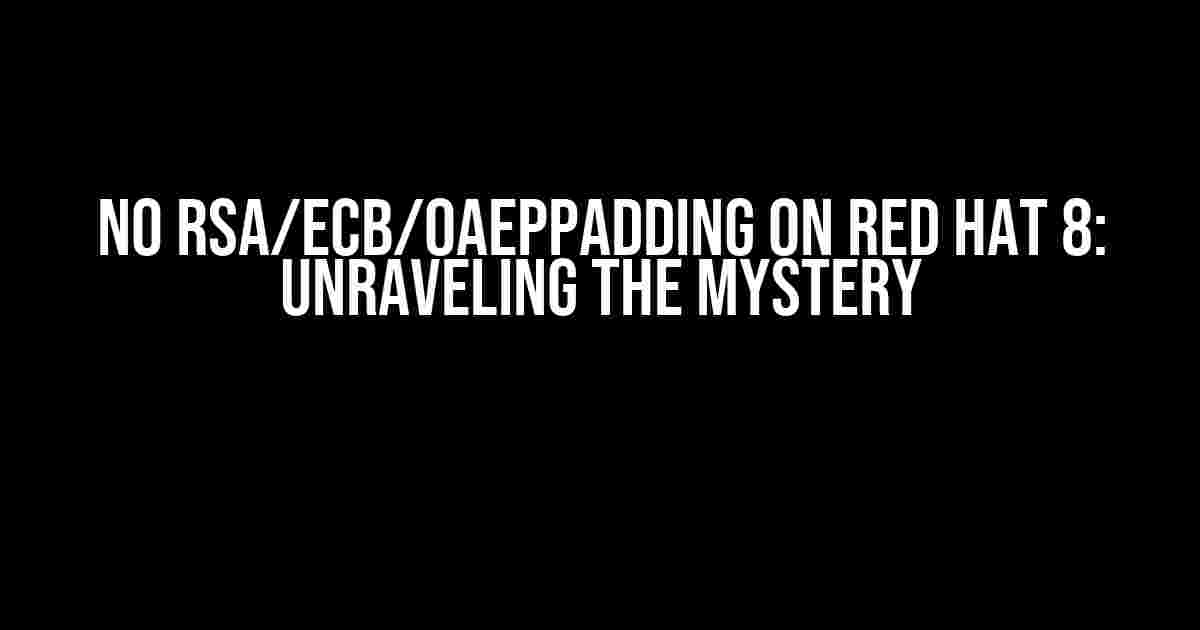Are you tired of encountering the “No RSA/ECB/OAEPPadding” error on Red Hat 8? You’re not alone! Many users have stumbled upon this issue, only to find themselves lost in a sea of technical jargon. Fear not, dear reader, for we’re about to demystify this enigmatic error and provide you with a comprehensive guide to resolving it once and for all.
What is No RSA/ECB/OAEPPadding, anyway?
Before we dive into the solution, let’s take a step back and understand what this error message is trying to tell us. In essence, it’s a cryptographic issue related to the way Red Hat 8 handles encryption. Specifically, it’s complaining about the lack of RSA/ECB/OAEPPadding, which is a set of encryption protocols used to secure data.
Here’s a brief breakdown of each component:
- RSA: A popular asymmetric encryption algorithm used for secure data transmission.
- ECB: Electronic Codebook mode, a block cipher mode that encrypts data in blocks.
- OAEPPadding: A padding scheme used in conjunction with RSA to ensure secure encryption.
The Problem: No RSA/ECB/OAEPPadding on Red Hat 8
So, why does Red Hat 8 throw this error? The reason lies in the way the operating system handles cryptographic libraries. You see, Red Hat 8 uses a different set of cryptographic libraries compared to its predecessors, which can cause compatibility issues with certain software applications.
The main culprits behind this error are:
- The lack of support for the RSA/ECB/OAEPPadding protocols in the OpenJDK 11 cryptographic providers.
- Incompatibility between the Red Hat 8 cryptographic libraries and the software application trying to use them.
The Solution: Enabling RSA/ECB/OAEPPadding on Red Hat 8
Fear not, dear reader, for we’ve got a comprehensive solution to overcome this hurdle. Follow these steps to enable RSA/ECB/OAEPPadding on Red Hat 8:
Step 1: Install the necessary packages
First, you’ll need to install the Bouncy Castle cryptographic provider, which supports RSA/ECB/OAEPPadding. Run the following command:
sudo dnf install bouncycastle
Step 2: Configure the Java Cryptography Extension (JCE)
Next, you’ll need to configure the JCE to use the Bouncy Castle provider. Create a new file called `java.security` in the `/etc/java-11-openjdk/conf/security/` directory with the following contents:
security.provider.1=org.bouncycastle.jce.provider.BouncyCastleProvider security.provider.2=sun.security.provider.Sun
This configuration tells Java to use the Bouncy Castle provider as the primary cryptographic provider.
Step 3: Update the application configuration
Now, you’ll need to update the configuration of the software application that’s throwing the error. This may involve modifying configuration files or environment variables to point to the Bouncy Castle provider.
For example, if you’re using a Java-based application, you might need to add the following JVM argument:
-Djava.security.provider=org.bouncycastle.jce.provider.BouncyCastleProvider
Step 4: Verify the configuration
Finally, verify that the configuration has taken effect by running the following command:
java -version
Look for the presence of the Bouncy Castle provider in the output:
java version "11.0.2" 2020-01-14 Java(TM) SE Runtime Environment 18.9 (build 11.0.2+9) Java HotSpot(TM) 64-Bit Server VM 18.9 (build 11.0.2+9, mixed mode) BouncyCastle Provider v1.67
Troubleshooting Common Issues
While the above steps should resolve the “No RSA/ECB/OAEPPadding” error, you might encounter some common issues along the way. Here are some troubleshooting tips to help you overcome them:
| Error Message | Solution |
|---|---|
| java.lang.SecurityException: JCE cannot authenticate the provider BC | Check that the Bouncy Castle provider is correctly installed and configured. |
| java.lang.NullPointerException: Invalid Provider: BC | Verify that the `java.security` file is correctly configured and that the Bouncy Castle provider is listed as the primary provider. |
| The software application still throws the “No RSA/ECB/OAEPPadding” error | Check the application’s configuration files and environment variables to ensure that they’re pointing to the Bouncy Castle provider. |
Conclusion
There you have it, folks! With these comprehensive steps, you should be able to resolve the “No RSA/ECB/OAEPPadding” error on Red Hat 8. Remember to carefully follow each step, and don’t hesitate to reach out if you encounter any issues along the way.
By enabling RSA/ECB/OAEPPadding on Red Hat 8, you’ll be able to harness the power of secure encryption, ensuring that your data remains protected and your applications run smoothly. Happy troubleshooting!
Frequently Asked Question
Get the scoop on the mysterious case of the missing padding algorithms on Red Hat 8!
What’s the deal with no RSA/ECB/OAEPPadding on Red Hat 8?
Red Hat 8 has deprecated the insecure RSA/ECB/OAEPPadding algorithms due to security concerns. These algorithms have been shown to be vulnerable to attacks, and it’s recommended to use more secure alternatives like OAEP or PKCS instead.
What are the security risks associated with RSA/ECB/OAEPPadding?
The RSA/ECB/OAEPPadding algorithms have been shown to be vulnerable to various attacks, including Bleichenbacher’s attack, which can lead to decryption of sensitive data. This is because these algorithms don’t provide sufficient padding, making it easier for attackers to exploit weaknesses in the encryption scheme.
What are the alternative padding algorithms that I can use?
You can use OAEP (Optimal Asymmetric Encryption Padding) or PKCS (Public-Key Cryptography Standards) instead of RSA/ECB/OAEPPadding. These algorithms provide better security and are widely supported by most cryptographic libraries and frameworks.
How do I configure my application to use the alternative padding algorithms?
You’ll need to update your application’s configuration to use the alternative padding algorithms. This typically involves modifying the cryptographic library or framework settings to specify the new padding algorithm. Consult your application’s documentation or seek guidance from a cryptography expert if you’re unsure about the specific steps.
What if I still need to use RSA/ECB/OAEPPadding for backward compatibility?
While it’s not recommended, you can still use RSA/ECB/OAEPPadding for backward compatibility purposes. However, be aware that this may compromise the security of your application. Consider implementing a hybrid approach that uses the more secure alternative algorithms for new connections andonly falls back to the insecure algorithms for legacy compatibility.
